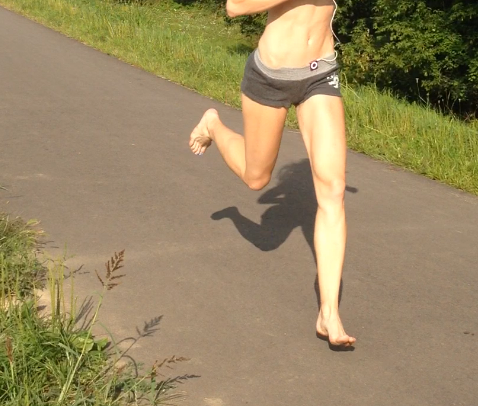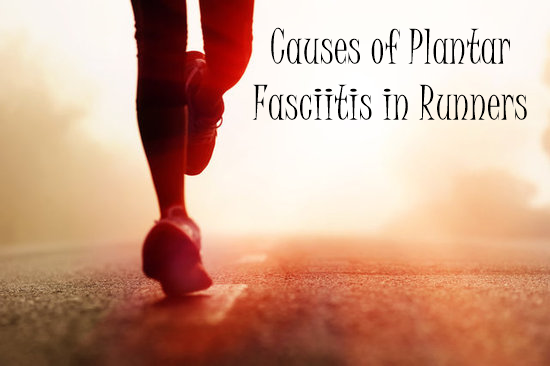What are the main causes of plantar fasciitis in running? In most cases, plantar fasciitis is caused by chronic overloading due to incorrect foot strike and improper footwear.
Causes of Plantar Fasciitis
Cushioned Running Shoes
Most runners prefer the standard running shoe, and many of these runners heel strike which is followed by foot rollover where the weight of the body is heavily loaded on the plantar fascia.
The standard running shoe may also cause a heel strike runner to drop from a greater height, altering dynamic factors that increases load magnitude on the foot [1]. This is how heel strike running may cause plantar fasciitis, a degenerative condition, to become chronic (degenerative = chronic = permanent).
Foot Strike – Heel Strike vs Forefoot Strike Landings
The weight-bearing patterns on the foot differ between forefoot and heel strike running –partly because foot rollover is absent in forefoot running.
- Past reports suggests that the arch and plantar fascia are more structurally efficient for the weight-bearing during stance in forefoot running than in heel strike running [2].
Still, most researchers believe that arch height and pronation are major risk factors for plantar fasciitis in runners. However, much of this research was on heel strike runners. Therefore, arch height and pronation may cause plantar fasciitis in heel strike runners, but researchers are only now beginning to explore whether these factors cause plantar fasciitis in forefoot runners, too.
Fascia Pain Treatment
Many barefoot running advocates are radically optimistic about forefoot running preventing plantar fasciitis, and they have every reason to be.

- Plantar fasciitis is extremely rare in habitual barefoot running populations [3] –the predominant foot strike used when barefoot running is a forefoot strike.
Barefoot walking is also enough to reverse arch weakness, and some experts refer to this as ‘freedom from injury when barefoot-adapted” [3].
Ultimately, forefoot running does not cause plantar fasciitis because plantar loading that produces chronic overloading is significantly low and heel pressure are also low.
- At touchdown in forefoot running, heel pressures are low because the center of pressure begins at the forefoot and ends at the heel where pressure is the lowest.
Insidious heel pain is commonly reported in plantar fasciitis sufferers — this is why heel pads are prescribed [4] — but, it makes sense to avoid heel strike during running to take pressure off the heel and not rely on under-heel padding.
Another mechanism forefoot running reduces strain on the plantar fascia is by reducing ground contact time, reducing the duration of inappropriate rearfoot movements such as excessive pronation.
Overpronation was thought to be a static trait, however researchers have found that forefoot runners (e.g. barefoot runners) pronate less, suggesting that foot strike strongly influences pronation, therefore plantar fasciitis.
But why do some newbie forefoot runners get plantar fasciitis?
Plantar fasciitis suffered by a newbie forefoot runner is different from that suffered by a heel strike runner. Forefoot running learners appear to suffer temporary plantar fasciitis; heel strike runners appear to suffer the chronic form.
Because the human foot has not evolved strategies to accommodate high plantar loads in heel strike running, degenerative changes occur to the plantar fascia resulting in chronic plantar fasciitis in heel strike runners . Likewise, the standard running shoe –a shoe that accommodates heel strike– are aimed more squarely at over-protecting the foot, causing a loss of intrinsic foot strength, transferring higher applied loads to the plantar fascia.
- This overloading causes micro tears on many aspects of the plantar fascia [5].
A newbie forefoot runner experiences temporary plantar fasciitis because of adaptation. Learning this style of running involves changes at the level of arch deflection, but ultimately, forefoot running does not cause plantar fasciitis because the body weight does not saturate the plantar fascia partly because foot rollover is not a component in forefoot running.
Always Wear Less
Forefoot runners are encouraged to wear pure minimalist shoes without arch support, because doing so increases tactile simulation on the foot –tactile stimulate directly stimulates and strengthens the foot’s soft tissues.
- A major part of plantar fasciitis during forefoot running lies in poor intrinsic foot strength caused by previous long-term use of the standard running shoe.
Researchers have found that intrinsic foot strength, particularly in the muscles controlling the lowering/rising of the arch [3], serves as an innate shock absorber during barefoot running.
- When these muscles are strong, less load is applied to the plantar fascia [6].
Conditioning of the intrinsic foot musculature will occur eventually through forefoot running in pure minimalist shoes and plantar fasciitis will not become chronic due to the limited number of loadings applied on the foot.
More From Run Forefoot:
Patellofemoral Pain Syndrome – Many runners suffer this dreaded injury, but many runners don’t know why. This article covers the main cause of knee injury in runners.
Achilles Heel – Found out why heel strike running is such a daunting task for the Achilles tendon, resulting in injury to the tendon.
Eccentric Exercises – We often hear about eccentric exercises, but you can achieve them just by running barefoot; find out how.
Forefoot Shoe Review – Read my review on the FeelMax Osma 2, an under-appreciated forefoot running shoes that is a great tool to help you mechanically run your best.
References:
[1]. Pohl MB, Hamill J, Davis IS. Biomechanical and anatomic factors associated with a history of plantar fasciitis in female runners. Clin J Sport Med. Sep 2009;19(5):372-6. http://dx.doi.org/10.1097/JSM.0b013e3181b8c270
[2]. Robbins et al. Overload protection: avoidance response to heavy plantar surface loading. Med Sci Sports Excer, 1998; 20(1):85-92.
[3]. Robbins SE and Hanna AM. Running related injury prevention through barefoot adaptations. Med Sci Sports Exerc, 1987; 19:148-156.
[4]. Alfredson H, Lorentzon R. Chronic Achilles tendinosis: recommendations for treatment and prevention. Sports Med. 2000; 29(2):135-46.http://dx.doi.org/10.2165/00007256-200029020-00005.
[5]. De Garceau D, Dean D, Requejo SM, Thordarson DB. The association between diagnosis of plantar fasciitis and Windlass test results. Foot Ankle Int. Mar 2003;24(3):251-5.
[6]. Gautham P, Nuhmani S and Kachanathu SJ. Plantar fasciitis – an update. Bangladesh J Med Sci, 2014; 13(3):3-8.
Bretta Riches
BSc Neurobiology; MSc Biomechanics candidate, ultra minimalist runner & founder of RunForefoot. I was a heel striker, always injured. I was inspired by the great Tirunesh Dibaba to try forefoot running. Now, I'm injury free. This is why I launched Run Forefoot, to advocate the health & performance benefits of forefoot running and to raise awareness on the dangers of heel striking, because the world needs to know.
Latest posts by Bretta Riches (see all)
- Does Foot Strike Really Matter in Running? YES! - 17/04/2024
- Heel Lifts Increase Injury in Runners - 16/04/2024
- Are Minimalist Shoes Good for Seniors? YES! - 14/04/2024


Leave a Reply